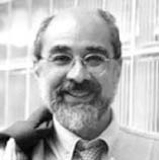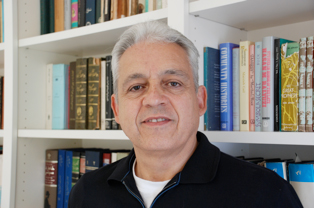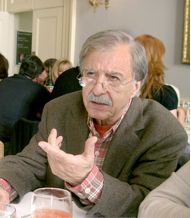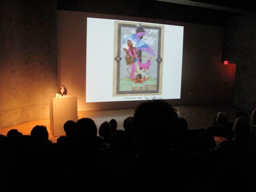Columbia University Fall Seminars on Iranian Studies
9/15/2011—12/15/20115:30 PM—7:30 PM
Faculty House of Columbia University 64 Morningside Drive New York, New York 10027
COLUMBIA UNIVERSITY SEMINARS
SEMINAR ON IRANIAN STUDIES
24th Consecutive Year
FALL 2011 PROGRAM
Ervand Abrahamian: September 15
Mehrdad Amanat: October 13
Ahmad Ashraf: November 17
Fereshteh Daftari: December 15
*************************************
PROF. ERVAND ABRAHAMIAN
Distinguished Prof. of History
Baruch College and CUNY Graduate Center
September 15, 2011
“Mosaddeq Era Revisited”

Summary
Much has been written on the oil nationalization crisis of 1951-53, as well as on the coup of 1953. Why revisit these two subjects? Conventional wisdom for the last sixty years has claimed that the US—as an “honest broker”--offered reasonable compromises, but that Mossadeq, because of intransigence and maybe a “martyrdom complex,” refused to accept--in other words, the fault lay entirely with Mossadeq. Conventional wisdom also argues that the coup had little or nothing to do with oil but much to do with the Cold War—fear of the Tudeh and the Soviet Union. Both aspects of conventional wisdom can be challenged by a close reading of the internal documents of the Foreign Office, State Department, and British Petroleum.
Bio-Notice
Prof. Abrahamian (M.A., Oxford University; Ph.D., Columbia University), an Armenian born in Iran and raised in England, teaches courses on world and Middle East history. He has published Iran Between Two Revolutions; Radical Islam: The Iranian Mojahedin; Khomeinism: Essays on the Islamic Republic; and Tortured Confessions: Prisons and Public Recantations in Modern Iran, and he co-authored Inventing the Axis of Evil: The Truth About North Korea, Iran, And Syria. His most recent book is A History of Modern Iran (Cambridge University Press, 2008), and he is currently working on The CIA Coup in Iran. He teaches at the CUNY Graduate Center and has taught at Princeton, New York University, and Oxford University.
*************************************
DR. MEHRDAD AMANAT
October 13, 2011
“Negotiating Identities: Iranian Jews Conversion to Islam and the Baha’i faith”

Summary
This presentation traces trends relating to conversion, assimilation and participation in public life by Jews of modern Iran, with special emphasis on conversions to the Baha’i faith. The modern Baha’i religion grew out of the messianic Babi movement in mid- nineteenth-century Iran. It attracted large numbers of mostly Muslim converts, but later its ecumenical message appealed to Iranian Jews who through conversion shared Iranian cultural values and greater harmony with Iranian identity.
It has been argued that Baha’i conversions highlight the convergence of a number of distinct processes at a time of grave historical change, most notably the advent of modernity and national integration. Many Jews migrated from ancient ghettos in order to benefit from economic and social mobility. At a time of high messianic expectations (a primordial theme among Persian Jews), a new faith promising equality and tolerance inspired a sense of optimism and the expectation of an end to prejudice and discrimination. Its acceptance of multiple religious identities provided the necessary space to negotiate new identities in new environments. Economic conditions necessitated a departure from the ghetto that gave the Jews a greater desire to rid themselves of the stigma of the “unclean” Jew and a willingness to re-evaluate traditional belief systems. Baha’i conversion to a large extent removed old cultural barriers and allowed greater assimilation.
Bio-Notice
Dr. Mehrdad Amanat, an independent scholar living in Los Angeles, received his M.A in Islamic Studies in 1979 and PhD in history, in 2006, both from the University of California at Los Angeles. He is a regular contributor to the Encyclopædia Iranica. His book, Jewish Identities in Iran: Resistance and Conversion to Islam and the Bahai Faith, is published by I.B.Tauris in 2011.
*************************************
PROF. AHMAD ASHRAF
Columbia University
November 17, 2011
“Changing Images of Iranian History and Identity.”

Summary
The long and eventful history of Iran has seen recurrent constructions, transformations, eclipses, and resurgences of Iranian images of its history and identity— interpreted on the basis of a number of contentious notions of ethnic and national identities. My survey on Iranian history and identity during the last two decades shows that the main development of Iranian identity, from its literary foundation during the Sasanian era to the present time, may be divided into the following Six Distinctive Ages:
1. The Age of Construction: Constructing a proto ethno-national identity during the late Sasanian era,
2. The Age of Nostalgia and Boasting: The Construction of New Iranian “Cultural Identity” Under the Iranian Regional Dynasties
3. The Age of the “Eclipse of Iran” and “Rise of Islam”: The Eclipse of Iranian identity during the Saljuq era.
4. The Age of Recovery: The Mongol and Timurid Eras.
5. The Age of Resurgence: The Reconstruction of a Hybrid Iranian-Shi’ite identity during the Safavid era.
6. The Age of Modern Nationalism and Rise of National Identity: During the 19th and 20th Centuries
Bio-Notice
Prof. Ashraf has taught sociology and the social history of Iran at the University of Pennsylvania, Columbia University, Princeton University, and Tehran University. He has served as Managing Editor of Encyclopædia Iranica since 1990. He is the author of several books and numerous articles, including Historical Obstacles to the Development of Capitalism in Iran (1980). His writings have covered such topics as social hierarchies in Iran’s history, tradition and modernity, Iranian identity from a Historical Comparative Perspective, agrarian relations in Persia, and charismatic leadership and theocratic rule in post-revolutionary Iran. Prof. Ashraf has served on the editorial board of Iranian Studies, International Journal of Politics, Culture, and Society, and Iran-Nameh. He has also served as a Trustee-at-Large of the American Institute of Iranian Studies from 1988-
1994.
*************************************
DR. FERESHTEH DAFTARI
December 15, 2011
“Contemporary Art by Iranian Artists: Perspectives and Stereotypes.”

Summary
The discourse on contemporary Iranian art needs to take into account the diversity of practices, issues and positions. It is necessary to move away from a monolithic representation of a single cultural identity and focus more on the variety of viewpoints.
The general overview of art by Iranian artists, residing both inside and outside the country, purports to highlight such pluralism.
Bio-Notice
In 1988 Dr. Fereshteh Daftari received her Ph.D. in art history from Columbia University. Her dissertation, The Influence of Persian Art on Gauguin, Matisse and Kandinsky, was published by Garland in 1991. As a curator in the department of Painting and Sculpture at The Museum of Modern Art, where she worked from 1988 to 2009, she organized a number of exhibitions with contemporary artists such as Xu Bing, Y.Z. Kami, Paul McCarthy, Shirin Neshat, and Shahzia Sikander. Interested in global modernities and cross-cultural currents, she guest- curated an exhibition of Iranian modern art at New York University’s Grey Art Gallery (2002) and Without Boundary: Seventeen Ways of Looking at The Museum of Modern Art (2006). Her publications include Another Modernism: An Iranian Perspective (2002); Beyond Islamic Roots –Beyond Modernism in RES (Spring 2002), and Islamic or Not in Without Boundary (2006). Since 2009, she has written a number of articles on contemporary artists such as Ali Banisadr (Thaddaeus Ropac Gallery, Paris), Mahmoud Bakhshi Moakhar (Saatchi Gallery, London), Shiva Ahmadi (CANVAS magazine), and Raqib Shaw (White Cube, London). Two forthcoming exhibitions (one on Iranian modern art at The Asia Society in New York, and one on Middle Eastern artists at MOA in Vancouver) and a book on Iranian modern and contemporary art are among the various projects she is currently working on.
To reach the Faculty House:
Enter the Wien Hall Gate on 116th Street between Amsterdam Avenue and Morningside Drive. Walk past Wien Hall, then turn right to the Faculty House.
Back to all events

